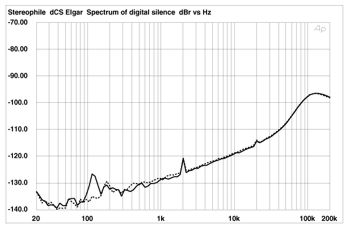| Columns Retired Columns & Blogs |
dCS Elgar D/A processor Measurements
Sidebar 3: Measurements
All measurements were performed at 44.1kHz. With pin 2 of its output XLRs connected as positive, the Elgar was noninverting with its front-panel phase switch set to Normal, inverting with it set to Inverting. The output impedance was very low (in the region of 1 ohm) from the balanced jacks, and somewhat higher (51 ohms) from the unbalanced RCAs. The output levels were inconsequentially lower than specified, at 2.95V/985mV balanced and 2.98V/990mV unbalanced. I haven't shown the Elgar's frequency-response or de-emphasis error graphs: both were flat within ±0.02dB (response) and ±0.075dB (error) limits. The channel separation, too, was excellent at better than 100dB up to 4kHz, with then a gentle reduction up to 88dB at 20kHz.
Fig.1 shows a 1/3-octave spectral analysis of the Elgar reproducing a 1kHz tone at -90dBFS. The top pair of traces are with the Audio Precision System One outputting dithered 16-bit data. The noise floor is basically that of the test signal. The lower pair of traces is with the data word width set to 20 bits. The data noise drops by 10dB or so, unmasking a very slight 120Hz power-supply component in the left channel. Excellent linearity is implied by the fact that the 1kHz component just reaches the -90dBFS line. But note the small blip at 2kHz: This could be second-harmonic distortion, or it could be something else.

Fig.1 dCS Elgar, spectrum of dithered 1kHz tone at -90.31dBFS, with noise and spuriae; 16-bit data (upper traces) and 20-bit data (lower traces) (1/3-octave analysis, right channel dashed).
To investigate further, I drove the Elgar with 20-bit data representing a subsonic tone, 4Hz, at a very low level, -100dBFS. Note the rise in the noise floor at high frequencies in the resulting output spectrum (fig.2), which will be due mainly to signal dither but also to the Elgar's noise-shaping. But note also that there is still a spectral component present at 2kHz. I suspect that this is either an "idle tone" of some kind—noise-shaping filters can lock into cyclical patterns when presented with data representing a very-low-level signal or no signal at all—or a spurious tone from the Audio Precision System One. However, at better than 120dB down from full level, I doubt that this behavior will have any subjective consequences.

Fig.2 dCS Elgar, spectrum of 4Hz tone at -100dBFS (20-bit data, 1/3-octave analysis, right channel dashed).
- Log in or register to post comments




































